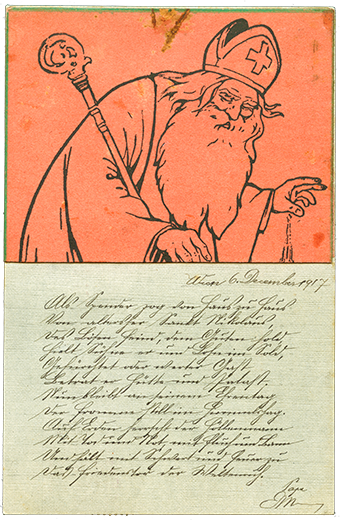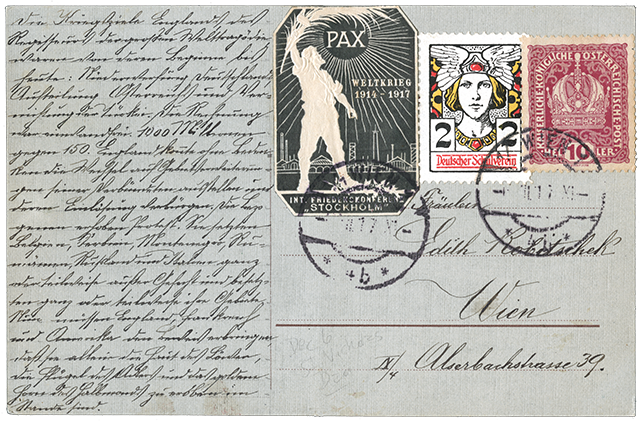
Home | Card Index | | | |
 Home | Card Index | | | | |
Eman Robitschek to Edith Robitschek - December 6, 1917Transcription and translation by Werner Sepper. |

|
||||
|
Als Spender zog von Haus to Haus Von altersher Sankt Nikolaus, Des Bösen Feind, dem Guten hold, Hielt Sühne er und Lohn im Sold, Gefürchtet oder werter Gast Betrat er Hütte und Palast. Nun bleibt an seinem Ehrentag Der Fromme still im Himmelshag. Auf Erden herrscht der Höllenmann Mit Tod und Not, mit Fluch und Bann Und hält mit Schwert und Feuer zu Das Friedenstor der Weltenreich. |
||||
|
As giver went from house to house Saint Nicholas since olden times, The enemy of bad, well disposed of good, He brought atonement and rewards in gold, He was feared or honored guest Entering hut and palace. Now on his honored day he remains The pious one in heavens grove. On earth rules the man from hell With death and need, with curse and spells And holds with sword and fire closed The gate of peace to worlds realm. |
||||
|
Christmas - 1917. St. Nicholas has retired to "heaven's grove" and there is no Christmas on Earth. Instead, the "man from Hell" holds forth, fanning the flames of war and baring the gate of peace. The essay on the other side of the card makes it clear that Eman believes that the man from Hell is none other than the King of England.
|
||||

|
 |
 |

|
 |

|
 |
|
|
In 1917, the International Socialist Bureau, which was the Executive Committee of the International, attempted to convene a peace conference in Stockholm, often referred to as the Stockholm Peace Conference. The idea was to get workers and their unions in all the countries at war to force peace by threatening to strike. The "1000 million" referred to by Eman are these workers and the countries listed are those in which "the common man" had already made it very difficult for them to prosecute the war fully. The peace conference failed to materialize because the allied countries refused to issue passports to delegates from their countries, and because most of labor was strongly nationalistic. Read about the Stockholm Peace Conference: - SHORT VERSION - LONG VERSION - |

|
 |
|
EMAN'S USE OF GERMANIA Eman uses the Deutscher Schulverein stamp that depicts Germania, the female spirit and guardian of Germanic peoples, to emphasize his message that the German people are peaceful by nature and, if heeded, would end the war. Although Germania, wearing her battle armor, was adopted as an official symbol of Germany, proper, where she adorned their postage stamps beginning in 1900 (used throughout WWI).
On the other hand, in the propaganda label, Germania is wearing Thor's helmet suggesting that she's no pushover. GERMANIA AND THE ART OF PROPAGANDA From the 1850s onwards, advertising, propaganda and gazettes had been developing a very sophisticated system of social and political symbols that made it possible to pack a complex, potent message into a very small visual space such as the propaganda label we are discussing here. If you click on the Schulverein label above left, it will open a separate image that you can compare side by side with the images below. The image at the left is of the Empress Sisi (Elisabeth), the wife of Emperor Franz Joseph, taken from a painting done in her middle years when her face has begun to fill out. When younger, her face was more heart-shaped like that in the label. Note, too, the red jewelry, which she frequently wore for formal occasions and which finds its echo in the propaganda label. Sisi was very popular both then and now. She detested being Empress, lost her daughter in tragic circumstances, and was struck down by an assassin in 1898. Echoing her image was bound to engage the empathy of the viewer. READ A BRIEF BIOGRAPHY OF SISI.
But wait! There's more! During Eman's life, the head of Mercury was used to decorate Zeitungsmarke (newspaper stamps) that were used to mail and tax newspapers and magazines. Mercury also wares a winged helmet. Usually, Mercury is depicted in profile on Austrian stamps of the period, but in 1920 a series was issued that shows Mercury from the front, as seen in the 2 heller newspaper stamp to the left. The look is very similar to that of the Schulverein propaganda label of Germania. The rim of Mercury's helmet is even pointed up in the front, an echo of the diadem fronting the helmet in the propaganda label. Thus, Eman may be invoking the messenger of the gods to bolster the authority of his message. Did Eman really intend all these layers of meaning? We will never know for certain, but it is absolutely certain that he had quite a knack for selecting images that layer and enhance the meanings in his poems and essays. This brings us to the first of two digressions that I simply could not resist. Why is that iconic figure from our own culture, Wonder Woman, wearing a diadem. She's not a queen or princess*, but then, neither was the Austrian Germania. Wonder Woman was created in 1941 to do propaganda battle with the Nazis. In this respect, she is the cultural mirror image of Germania, setting the Hellenic gods against the Norse gods and American exceptionalism against German imperialism. Just as Germania is the personification of the feminine aspect of the German people, Wonder Woman can be said to be the personification of the feminine aspect of the American people. *At least not in our country while representing us; back home in Thelmyscira she is an Amazon warrior princess during her second reincarnation. |

|
Second digression. In rooting about the internet, I found that Thor is being reborn in today's Austria. If you have any baby children or grandchildren with the thunderous personality of Thor, you might consider doing a little knitting along the lines shown here. Last revised 19 JAN 2014 |

|
 |
|
©2013-2014 by Charles M. Nelson All rights reserved. |